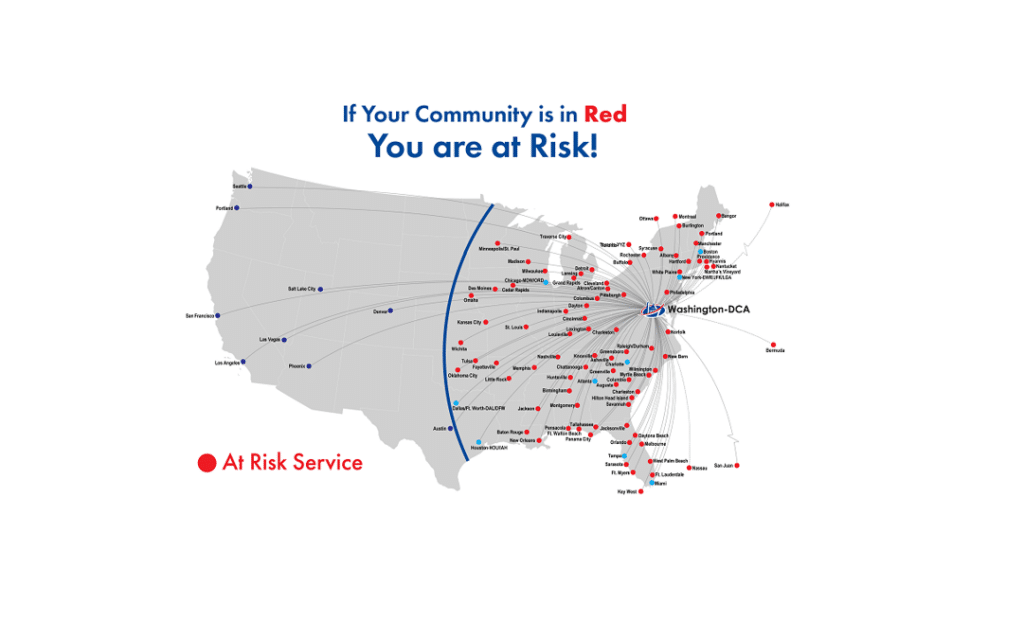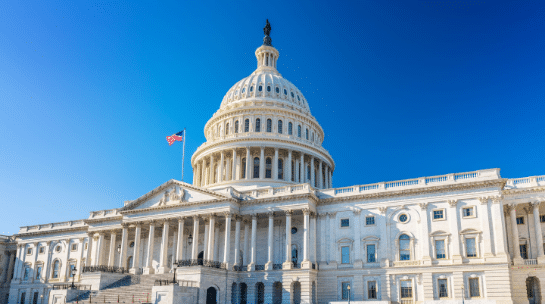Since 1987, the Metropolitan Washington Airports Authority (MWAA) has managed Reagan National (DCA) and Dulles International Airports (IAD) as a single system with complementary roles for the two airports. When Congress established MWAA, it entrusted this entity with overseeing the so-called “slot and perimeter rules” that were created in the 1960s to limit the number of flights to and from DCA as well as to designate a perimeter beyond which flights could not travel. These rules were created out of concern for DCA’s limited physical size and capacity and its proximity to noise-sensitive residential areas, as well as to ensure DCA fulfills its intended objective of providing access to the nation’s capital for regional airports and smaller communities within the perimeter. DCA is currently at capacity and at risk of being seriously overburdened should there be changes to the slot and perimeter rules. Moreover, any changes to the slot and perimeter rules threaten to undermine the access of regional airports and their communities to the D.C. area, as well as increase delays, traffic, congestion, noise, and safety concerns.
We believe that airport authorities – working with local communities and lawmakers – are best placed to make operational decisions at our airports, which will lead to safer, more convenient, and sustainable air travel.

The proposed changes will risk service to Washington as they will incentivize airlines to reduce service within the perimeter and expand more profitable service to long-haul destinations. The reduction of service to in-perimeter destinations will therefore threaten the jobs, economic growth, and other investments that communities have made in their regional airports, transportation infrastructure, and local economies.
Members of Congress should be focused on fixing pilot and air traffic controller shortages, supporting an industry still recovering from the pandemic, and promoting safety and security.


With the shortage in pilots and air traffic controllers, these proposed changes are not sustainable and will cause further delays and daily disruption at our airports.
IAD has invested in additional Metro service and a new state-of-the-art concourse, which will support long-term employment, aircraft and passenger services, and economic growth.

FACT: Washington, D.C. already enjoys world-class access to destinations around the U.S. and across the globe through three major airports that are accessible by public transit: DCA, IAD, and BWI.[2]
FACT: DCA is at capacity and already has the 3rd worst cancellation rate, trailing only LaGuardia and Newark.[3]
FACT: Changes to the slot and perimeter rules will incentivize airlines to reduce short-haul service for more profitable long-haul service,[4] threatening access for cities inside the perimeter and smaller communities that connect to, or through, Washington.[5]
FACT: DCA’s 58 gates are already jammed throughout the day, often meeting the industry maximum.[7]
FACT: DCA is at capacity, with no room to grow, and cannot accommodate more flights due to geographic limitations and airside capacity.[8]
FACT: An additional 28 flights per day would add nearly 9,000 passengers per day to DCA – or 3.3 million additional passengers per year.[9]
FACT: If the proposed changes become law, DCA would be forced to handle 12.6 million passengers beyond what it was designed to handle, without any regard for the impact on passenger safety or convenience, and the physical constraints of the airport itself.[10]
FACT: DCA is one of only 3 airports in the country where the FAA has capped flights to directly manage congestion, and it operates today at the maximum allowed under this cap.[11]
FACT: Additional flights would increase flight delays, lower opportunities to recover operations in the event of delays, and result in planes burning more fuel from longer taxi times.[12]
FACT: Increasing flights from larger planes that carry even more passengers will further crowd terminals, gates, boarding areas, and baggage systems.[13]
FACT: DCA’s recent renovation focused on overdue gate, terminal and security improvements. It did not add any capacity to handle additional flights.[14]
FACT: Adding flights will lead to more noise, delays, congestion, and reduction of service to cities around the country.[16]
FACT: For every flight added outside of the perimeter, an in-perimeter flight is at risk, especially those to smaller communities that depend on that connection for their own local economies.[17]
FACT: Recent investments near IAD including the Silver Line Metrorail station and the announcement of a new state-of-the-art concourse, as well as the long-term employment created in airport concessions and aircraft and passenger services, will be at risk if these changes are made.[18]
FACT: DCA is facing a 27% shortage of certified air traffic controllers below its FAA target number. Additional flights will further increase the burden on air traffic controllers.[20]
FACT: Already, about 20% of departures and 22% of arrivals at DCA experience average delays of 67 minutes. The addition of 20 daily round-trip operations would increase delays by 25.9%, and the addition of 25 daily round-trip operations would increase delays by 33.2%.[21]
FACT: Adding more passengers and flights to DCA will increase strain on the airport’s systems.[22]
FACT: The opposite is true, as more military personnel are located in the perimeter than outside of it – meaning more military personnel are actually at risk of losing access than gaining it should changes to the slot and perimeter rules be enacted.
FACT: According to Governing.com, the District of Columbia and the 38 states located either fully or partially inside the perimeter are home to 634,574 active duty military personnel, while the 18 states fully or partially outside of the perimeter are home to 391,309 active duty military personnel. The military population of in-perimeter states currently served by DCA is 1.6 times the military population of out-of-perimeter states.[23]
FACT: The Metropolitan Washington Airports Authority (MWAA), the local airport authority created by Congress to make operational decisions for the airport, has repeatedly stated that DCA is at capacity.[25]
FACT: The Federal Aviation Administration (FAA) says DCA is more delay-prone than other airports, and estimates that adding 20 daily round trip operations would further increase delays by 25.9% while adding 25 daily round trip operations would increase delays by 33.2% at DCA.[26]
FACT: DCA already averages 50-55 operations in peak hours, except between 9:00 PM and 10:00 PM, with planes taking off and landing on the same short runway.[27] No airport – especially slot-controlled airports that operate with significant geographic and flight restrictions – can operate at peak capacity at all hours without consequences like delays, cancellations, and other disruptions.[28]
FACT: DCA is one of only three airports in the country where the FAA uses slots to limit air traffic due to capacity constraints, and the FAA has said no more flights can be added. [29]
FACT: Off-peak hours are necessary to recover from congestion in peak hours, preventing delays from compounding and becoming worse.
FACT: The extra time buffer of one minute between flights identified at DCA reflects underperformance – not the ability to add more flights – as the airport’s limited capacity needs added padding to facilitate timely flights.[30]
FACT: The DCA Act does not protect flights to in-perimeter destinations. Any destinations within the perimeter are at risk for lost or reduced service,[32] as airlines will be incentivized to change their short-haul routes to feed their new, more profitable long-haul service.
FACT: Additionally, the additional 56 takeoffs and landings per day proposed by the DCA Act will bring DCA to a standstill because the airport is at capacity, more delay-prone compared to other airports, and has the busiest runway in the country. This will increase delays and disruption at DCA with a significant impact on regional airports and the passengers trying to connect to or through Washington.[33]
FACT: The perimeter rule was created to preserve DCA’s intended role as a short-haul regional airport,[35] which is complemented by the long-haul flights offered at both Dulles International Airport (IAD) and Baltimore-Washington International Airport (BWI).
FACT: The perimeter rule is also important because airlines tend to use larger aircraft to operate longer-haul flights, and DCA’s runways — which are far shorter[36] than those at IAD[37] and other long-haul airports — already struggle to accommodate the larger aircraft that serve these long-haul flights.[38]
FACT: IAD has the ground space and capacity to serve a far greater number of passengers than it currently handles, while DCA is already well over capacity. Both DCA and IAD serve around 24 million passengers per year. However, with minor expansions IAD’s current facilities could accommodate 45 million annual passengers, while DCA is already serving 9 million more passengers per year than originally intended.[39]
FACT: This is unsurprising when you look at the numbers: DCA has only 58 gates on 733 acres of land,[40] compared to 135 gates on approximately 12,000 acres at IAD.[41]
FACT: With DCA already at capacity, the perimeter rule is more necessary today than in the past.
FACT: Virginia voters in no way benefit from changes to the slot and perimeter rules that will increase delays, cancellations, traffic, noise, and safety concerns in their community.
FACT: This local opposition is exemplified by the strong public positions taken by federal lawmakers that represent these communities — among them Governor Glenn Youngkin, Sens. Tim Kaine and Mark Warner (D-VA), Sens. Chris Van Hollen and Ben Cardin (D-MD), and Del. Eleanor Holmes Norton (D-DC) — as well as by the 44 Virginia, D.C, and Maryland-based groups that have joined the Coalition to Protect America’s Regional Airports to oppose any changes to these rules.
FACT: There are more active-duty military personnel located within the perimeter-and therefore at risk of seeing lost or reduced access to Washington and longer delays and cancellations due to more flights at DCA than it can reasonably handle-than outside the perimeter.
FACT: The District of Columbia and the 37 states located either fully or partially inside the perimeter are home to more than 718,263 active duty military personnel, 1.5 times more than the 476,816 living in the 19 states partially or fully outside of the perimeter.[43]
FACT: There is robust competition and consumer choice for passengers looking for flights in the D.C. area, as evidenced by the careful balance between an already at-capacity DCA, and IAD and BWI, both of which have room to grow and provide passengers with more options.[44]
FACT: The cost of flying in the D.C. area is around the average amongst large U.S. cities, and is less expensive than four major Delta hubs.[45]
FACT: Low-cost carriers have a 44% share of the domestic market in the D.C. area, one of the highest among major U.S. cities.[46] Additionally, 93% of all D.C. area travelers have the option of flying on a low-cost carrier, above the national average.[47]
FACT: Due to the perimeter rule, D.C. area travelers have non-stop service to more communities within 1,250 miles than travelers do in New York City, and twice as many as travelers do in coastal hubs like Seattle or Boston.[48]